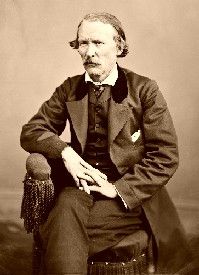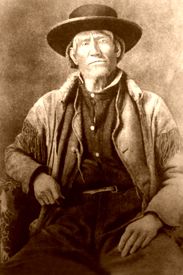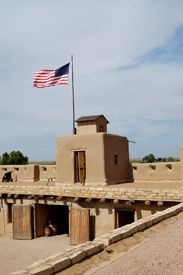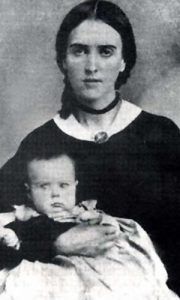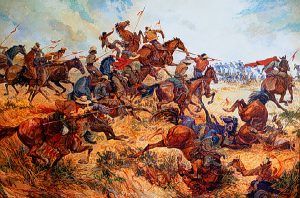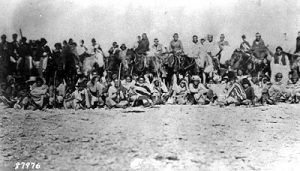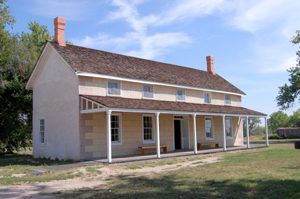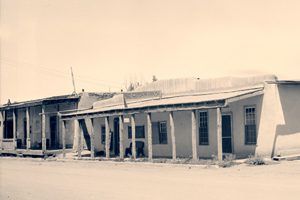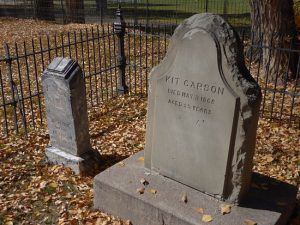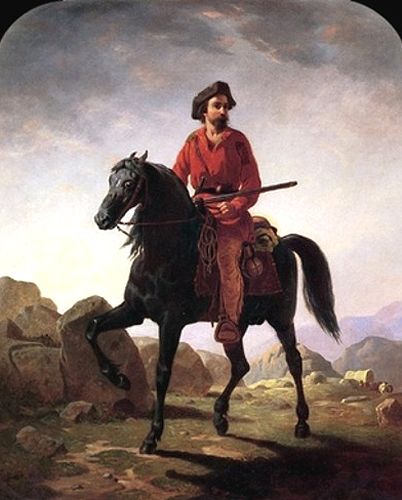
Kit Carson in 1854, painting by William Ranney.
“We shall not cease from exploration
And the end of all our exploring
Will be to arrive where we started
And know the place for the first time.”
–T. S. Elliot
American frontiersman, trapper, soldier, and guide Christopher Carson, better known as Kit Carson, is one of the great heroes of the Old West. During the early 1800s, Carson was a legendary mountain man and free trader in the American Southwest. He gained renown for his fur trade and trail-blazing efforts in New Mexico and westward to California. He served as a United States military guide, an American Indian agent, and a celebrated aide during the Mexican-American War. His extensive travels and experience tell a story of not just one man but of many people and cultures throughout the area of what would become the Southwestern United States.
Christopher Houston Carson was born on December 24, 1809, in Madison County, Kentucky, to Lindsey Carson, a veteran of the American Revolution, and Rebecca Robinson Carson. He was a cousin to another famous frontiersman, Daniel Boone, through his mother. When he was two years old, the family moved to Howard County, Missouri, where Carson spent most of his early childhood in Boone’s Lick. Also living there was William Becknell, who would blaze the Santa Fe Trail in 1821. When Becknell returned, the news of his successful trip attracted wide attention, and the new community of Franklin, Missouri, near Boone’s Lick, became the birthplace of the Santa Fe Trail.
As part of a large family, survival on the frontier was the priority, and Carson never learned to read or write. His father died when he was only nine years old. Despite being penniless, his mother took care of her children alone for four years before remarrying. When Kit was 14, he went to work as an apprentice in Workman’s Saddleshop in nearby Franklin. By this time, the Santa Fe Trail was two years old, and many of the customers were trappers and traders from whom Kit would hear stories about the frontier. Kit did not get along with his stepfather and didn’t like the saddle trade. When he was 16, he secretly signed on with a large merchant caravan heading to Santa Fe, arriving at their destination in November 1826.
From Santa Fe, Kit went north to Taos, where he worked as a cook, errand boy, and harness repairer. At this time, he was just five feet, five inches tall, weighed 140 pounds, and was slightly bow-legged. He was described as softly spoken and possessed a great natural modesty.
When he was 19, he was hired for a fur trapping expedition to California. Despite his small stature, he soon proved himself able and courageous.
Between 1828 and 1840, Carson used Taos as a base camp for many fur-trapping expeditions throughout the mountains of the West, from California’s Sierra Nevada Mountains to the Rocky Mountains. During this time, he met other famous frontiersmen, including Jim Bridger, Tom Broken Hand Fitzpatrick, and Dr. Marcus Whitman. His best friend, Lucien Maxwell, who owned the largest land grant in New Mexico, would eventually become his brother-in-law.
As with many white trappers, Carson became somewhat integrated into the Indian world, traveling and living extensively among them. At one point, he married an Arapaho woman named Singing Grass, with whom he would have a daughter named Adaline Carson in 1837. Sometime later, Singing Grass died while giving birth to a second child. With Adaline needing a mother, Kit next married a Cheyenne woman called Making-Out-Road. She soon divorced him in the Indian style in 1840.
Carson was unusual among trappers, noted for his self-restraint and sober lifestyle. According to one acquaintance, he was “Clean as a hound’s tooth,” and a man whose “word was as sure as the sun comin’ up” was noted for his unassuming manner and implacable courage.
Around 1840, Carson was employed as a hunter for Bent’s Fort, Colorado garrison, and soon became its chief hunter.
In 1842, while returning from Missouri, where he took his daughter to be educated in a convent, Carson met John C. Fremont on a Missouri Riverboat. Fremont hired Carson as a guide for his first expedition to map and describe Western trails to the Pacific Ocean. Over the next several years, Carson helped guide Fremont to Oregon and California through much of the Central Rocky Mountains and the Great Basin. His service with Fremont, celebrated in Fremont’s widely-read reports of his expeditions, quickly made Kit Carson a national hero, presented in popular fiction as a rugged mountain man capable of superhuman feats.
During the early 1840s, Carson established his permanent residence in Taos, New Mexico. After returning to Taos from California, Carson married his third wife, Maria Josefa Jaramillo, the daughter of a prominent Taos family, in February 1843. A visitor described Josefa: “Her style of beauty was of the naughty, heart-breaking kind, such as would lead a man with the glance of the eye, to risk his life for a smile.” Together, they would have eight children. Josefa’s sister, Maria Ignacia Jaramillo, was married to noted fur trader Charles Bent, who would later become New Mexico’s first governor. The same year, he purchased a home in Taos for his family. Except for its 1825 date of construction, little is known about the Spanish-Colonial style residence before the Carsons purchased it. Today, the home is a National Historic Landmark and is one of the only remaining physical reminders of Carson’s life.
Carson’s notoriety grew as his name became associated with several key events in the United States’ westward expansion. He was still serving as Fremont’s guide when Fremont joined California’s short-lived Bear Flag rebellion just before the outbreak of the Mexican-American War in 1846. Carson would serve in the war, playing an important part in the conquest of California.
Carson also led the forces of U.S. General Stephen Kearny from Socorro, New Mexico, into California when a Californio band led by Andrés Pico mounted a challenge to the American occupation of Los Angeles later that year. On December 6, 1846, these forces were attacked by Mexicans at San Pasqual, about 30 miles north of San Diego. On the third night of this battle, Carson and two others snuck through enemy lines and ran the entire distance to San Diego, where they brought help for Kearny’s pinned-down forces. Emerging as the hero of the Battle of San Pascual, many people soon sought him out, but they were invariably surprised to meet the great man himself.
“His fame was then at its height, from the publication of Fremont’s book, and I was very anxious to see a man who had achieved such feats of daring among the wild animals of the Rocky Mountains and still wilder Indians of the Plains. I cannot express my surprise at beholding a small stoop-shouldered man with reddish hair, freckled face, soft blue eyes, and nothing to indicate extraordinary courage or daring.”
— Lieutenant William Tecumseh Sherman, upon being introduced to Carson at military headquarters in Monterey, California, in the fall of 1847
In April 1847, Kit Carson was away from home when the deadly Taos Revolt erupted. In the rebellion, his brother-in-law, Governor Charles Bent, was murdered while protecting Josefa and her sister from a rebellious mob. Afterward, Carson, who was devoted to his young wife, began to be more anxious to stay home, stating:
“We had been leading a roving life long enough, and now was the time, if ever, to make a home for ourselves and children.”
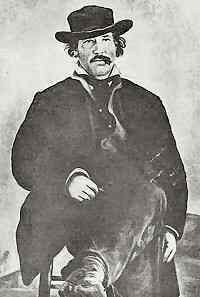
Lucien B. Maxwell.
Determined to settle down, he invested $2,000 in a ranching and farming enterprise with his old friend Lucien Maxwell. Through marriage, Maxwell inherited the largest land grant in U.S. history. Situated along the Cimarron River about 65 east of Taos, the two purchased stock and seeds and hired workers to erect buildings on Rayado Creek. Though the area was exposed to Plains Indian raiders, it was also located along the mountain branch of the Santa Fe Trail. While Maxwell moved his family there in 1849, Carson was reluctant, as Josefa had just given birth to a new baby. However, he did build a small house there.
That year, he was called to guide soldiers on the trail of Jicarilla Apache and Ute Indians who had committed the White Massacre in northeastern New Mexico. After the battle, Mrs. Ann White, her servant, and her baby daughter were kidnapped. Mrs. White was later found dead, but the servant and her daughter were never found.
By 1853, he and his partner, Lucien Maxwell, were able to drive a large flock of sheep to California, where gold rush prices paid them a handsome profit. In 1854, he was appointed Indian agent for the Ute and Apache at Taos, New Mexico, a post he held until the Civil War imposed new duties on him in 1861. These years of serving as an Indian Agent were the longest period at home with his family. He helped organize New Mexican infantry volunteers during the Civil War, which saw action at Valverde in 1862. However, most of his military actions were directed against the Navajo Indians, many of whom had refused to be confined upon a distant reservation set up by the government.
Beginning in 1863, under orders from his commanders in the U.S. Army, Carson waged a brutal economic war against the Navajo in an attempt to relocate them, marching through the heart of their territory to destroy their crops, and rounding up their livestock, some of which was later given to those who surrendered.
When the Ute, Pueblo, Hopi, and Zuni, who for centuries had been prey to Navajo raiders, took advantage of their traditional enemy’s weakness by following the Americans onto the warpath, the Navajo were unable to defend themselves. In 1864, most surrendered to Carson, who treated them well but was ordered to force nearly 8,000 Navajo men, women, and children to take what came to be called the “Long Walk” of almost 300 miles from Arizona to Fort Sumner, New Mexico. The U.S. military was unprepared for the large number of Navajo, and in only a couple of years, the ill-planned site became disease-ridden, with the ground depleted. In 1868, the Navajo were allowed to return to their land along the Arizona-New Mexico border.
In 1865, Carson was given a commission as Brigadier General and cited for gallantry and distinguished service. In the summer of 1866, he moved to Colorado to expand his ranching business and took command of Fort Garland. Ill health forced him to resign the following year, and in late 1868, the family moved to Boggsville, near present-day Las Animas, Colorado. Early that same year, at the urging of Washington and the Commissioner of Indian Affairs, Carson journeyed to Washington, D.C., where he escorted several Ute Chiefs to meet with the President of the United States to plead for assistance to their tribe. Although his health suffered again after his travels, he awaited an appointment as an Indian Agent for the Cheyenne and Arapaho in Colorado. Soon after his return, his wife, Josefa, died on April 23, 1868, from complications after giving birth to their eighth child.
Her death was a crushing blow to Carson, and he was soon taken to Fort Lyon, Colorado, where he would die just one month later, on May 23, 1868. In the presence of Dr. Tilton and his friend Thomas Boggs, his last words were, “Goodbye, friends. Adios, compadres“. Carson died from an abdominal aortic aneurysm. Carson was transported to Boggsville and buried beside his third wife, Josefa. A year later, both bodies would be taken to Taos, New Mexico, for their final burial. The local cemetery soon became the Kit Carson Cemetery in honor of the famous frontiersman.
Carson is still remembered for his many roles: trapper, explorer, Indian agent, and soldier. With his tremendous life experiences, he has come to symbolize the American West.
After his death, the Kit Carson House changed ownership several times before Bent Lodge #42, a Masonic Order, purchased the home in 1910. Carson was the founder of the parent order in Taos, New Mexico, during his lifetime. When the Lodge acquired the property, it was in disrepair, with broken windows, a collapsed roof, and much of the space used as stables. The Lodge established the Kit Carson Memorial Foundation, Inc., in 1952 to raise awareness and money to restore and interpret the property.
Today, the house reflects the aesthetics of late 18th-century Spanish influence combined with traditional American Indian building traditions and materials. The one-story adobe building is U-shaped and surrounds an open patio in the rear. Outwardly, it is relatively simple: the home’s most prominent architectural feature is a long, low wooden porch along its front façade. The Carsons did not alter the house’s Spanish appearance during their time there. While Kit Carson was often away, he, Josefa, and six or seven of their children called this house their home for most of the next 25 years. Today, the Kit Carson Memorial Foundation carefully preserves the home, which is open to the public as a historic house museum.
Visitors can take a guided tour of the house and explore exhibits on Carson’s life and accomplishments. The museum also has a bookstore and a gift shop. Just around the corner in Kit Carson Memorial State Park is the local cemetery with the graves of Carson and his wife. Both of their tombstones are the originals: Kit Carson’s, installed in 1890, and Josefa’s, later, in 1908. An iron fence now rings the gravesite to protect the stones from souvenir hunters, who, around the turn of the century, had chipped away at Carson’s tombstone, causing severe damage to the marker.
©Kathy Alexander/Legends of America, updated August 2025.
Also See:
Kit Carson – The Nestor of the Rocky Mountains
The Largest Land Grant in U.S. History – Maxwell Land Grant
My Friend, Kit Carson by a Santa Fe Trail Driver
Sources:

